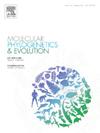Discordance between phylogenomic methods in Near Eastern mountain newts (Neurergus, Salamandridae)
IF 3.6
1区 生物学
Q2 BIOCHEMISTRY & MOLECULAR BIOLOGY
引用次数: 0
Abstract
Target enrichment by sequence capture allows researchers to collect genome-wide sequence data, suitable to re-evaluate complex systematic and taxonomic cases. The family Salamandridae is rife with rapid, successive speciation events, introgression and incomplete lineage sorting: factors that complicate the inferring of phylogenetic relationships and species boundaries. Phylogenetic relationships among, and the (sub)species status of, the taxa comprising the newt genus Neurergus are not fully resolved. We perform target enrichment by sequence capture to obtain ca. 7 k nuclear DNA markers, and conduct concatenated analysis with RAxML, gene-tree summary analysis in ASTRAL, and species tree estimation in SNAPPER, and investigate admixture between populations and genetic introgression with ADMIXTURE and Dsuite. We observe discordance between analyses pertaining to the placement of N. crocatus. We consider the placement of N. crocatus as sister to N. derjugini sensu lato in SNAPPER, instead of to N. kaiseri + N. derjugini sensu lato as in RAxML and ASTRAL, to be an artifact of introgression, as backed up by our Dsuite analysis. We show that N. strauchii barani and N. strauchii munzurensis, often treated as distinct species, are deeply nested within N. strauchii sensu stricto and should not be treated as species. Keeping them as subspecies would render the nominotypical subspecies as polyphyletic. Furthermore, we confirm that N. derjugini microspilotus should not be considered a distinct species, but as a subspecies of N. derjugini sensu lato. We consistently recover the northern and southern lineages of N. kaiseri as distinct genetic groups with geographically restricted admixture and recommend that these are treated as two distinct species. Our study highlights the strength of target enrichment by sequence capture in resolving systematic and taxonomic questions in taxa with a history of genetic admixture and introgression.

近东部山区蝾螈(蝾螈科,蝾螈科)系统基因组学研究方法的差异。
通过序列捕获的目标富集使研究人员能够收集全基因组序列数据,适用于重新评估复杂的系统和分类学案例。蝾螈科充满了快速的、连续的物种形成事件、渗入和不完整的谱系分类:这些因素使系统发育关系和物种界限的推断复杂化。神经蝾螈属(Neurergus)分类群的系统发育关系和亚种地位尚未完全确定。我们通过序列捕获进行目标富集,获得约7 k个核DNA标记,并使用RAxML进行连接分析,在ASTRAL中进行基因树汇总分析,在SNAPPER中进行种树估计,并使用admix和Dsuite研究群体之间的混合和遗传渗入。我们观察到关于鳄鱼的位置的分析之间的不一致。我们认为在SNAPPER中,N. crocatus是N. derjugini sensu lato的姐妹,而不是N. kaiseri + N。在RAxML和ASTRAL中,derjugini senssulato是一种渗透的产物,这一点得到了我们的Dsuite分析的支持。研究结果表明,barani和munzurenstrauchii通常被视为不同的物种,但它们深深地嵌套在strauchii sensenu stricto中,不应被视为物种。将它们作为亚种将使命名典型亚种具有多种性。此外,我们还证实,微spilotus不应该被认为是一个独立的种,而应该被认为是假乳假乳的一个亚种。我们一致地恢复了北方和南方的kaiseri谱系作为不同的遗传群体,具有地理限制的混合,并建议将它们作为两个不同的物种处理。我们的研究强调了序列捕获在解决具有遗传混合和遗传渗入历史的分类群的系统和分类问题方面的优势。
本文章由计算机程序翻译,如有差异,请以英文原文为准。
求助全文
约1分钟内获得全文
求助全文
来源期刊
CiteScore
7.50
自引率
7.30%
发文量
249
审稿时长
7.5 months
期刊介绍:
Molecular Phylogenetics and Evolution is dedicated to bringing Darwin''s dream within grasp - to "have fairly true genealogical trees of each great kingdom of Nature." The journal provides a forum for molecular studies that advance our understanding of phylogeny and evolution, further the development of phylogenetically more accurate taxonomic classifications, and ultimately bring a unified classification for all the ramifying lines of life. Phylogeographic studies will be considered for publication if they offer EXCEPTIONAL theoretical or empirical advances.

 求助内容:
求助内容: 应助结果提醒方式:
应助结果提醒方式:


